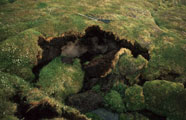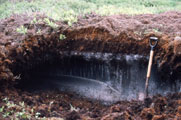 |
|
|
|
|
|
|
Perennially frozen materials are mostly complex mixtures containing rock material, ice, water, air and minerals salts. The relative amount of each component depend on the freezing processes. The freezing process can proceed epigenetically in an existing material or syngenetically in an ongoing sedimentation. The ice content is usually higher in epigenetic than in syngenetic permafrost. In contrast to sedimentary glacier ice, permafrost contains predominantly ‘primary’ congelation ice-segration ice. |
|
The freezing process is mainly influenced by: |
|
|
The freezing process has three main phases: |
|
| Look at the differences between slow and fast freezing: | |
|
The speed of freezing front formation is very important in determining the composition of the frozen material: |
|
|
|
|
The ice content and ice forms of a permafrost body are important since it is mainly these properties that influence the geotechnical properties of the ground. The ice content varies depending on
Fine material (such as silt and sand) is batter able to store water within its pores than coarse material (such as gravel). Therefore ice lens building is more prevalent in silt than in gravel. |
|
One can distinguish different ice content forms in permafrost: |
|
|
Extreme ice building can be observed at the permafrost table. As a general trend, supersaturated permafrost decreases with depth. |
|
The most important ice forms are: |
|

|
 |
 |
|
2 - Segregation ice (ground ice), Spitzbergen, Svalbard (128K) |
3 - Injection ice (140K) | 4 - Ice wedge (100K) |
| The following graphic shows the factors influencing ice forms. Different temperatures and the location of the freezing front are decisive. Ground thickness and material also play an important role. |
|
|
|
5 - Important factors in producing different ice forms (M. Hoelzle) |
29 August 2011 |
||
| |
||

